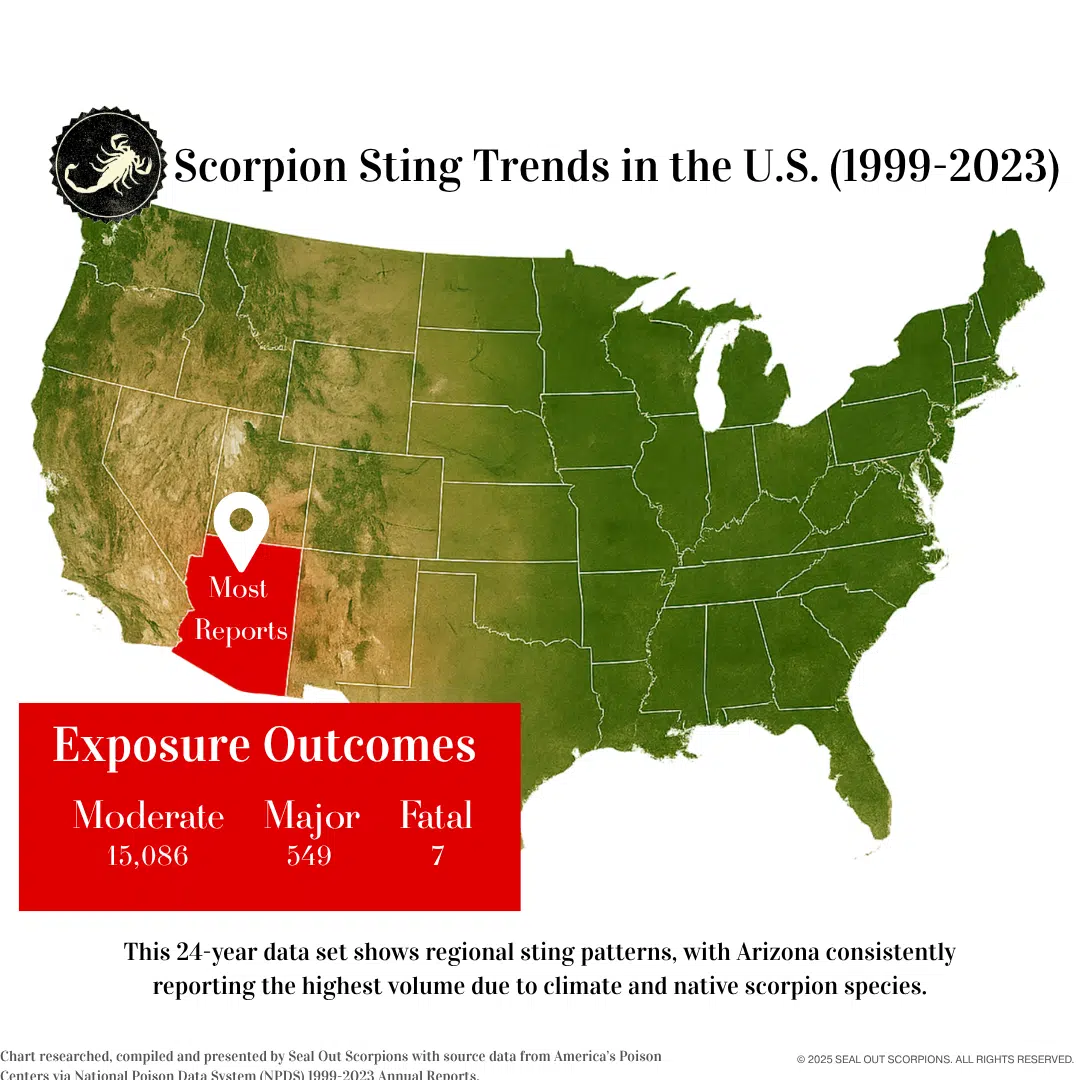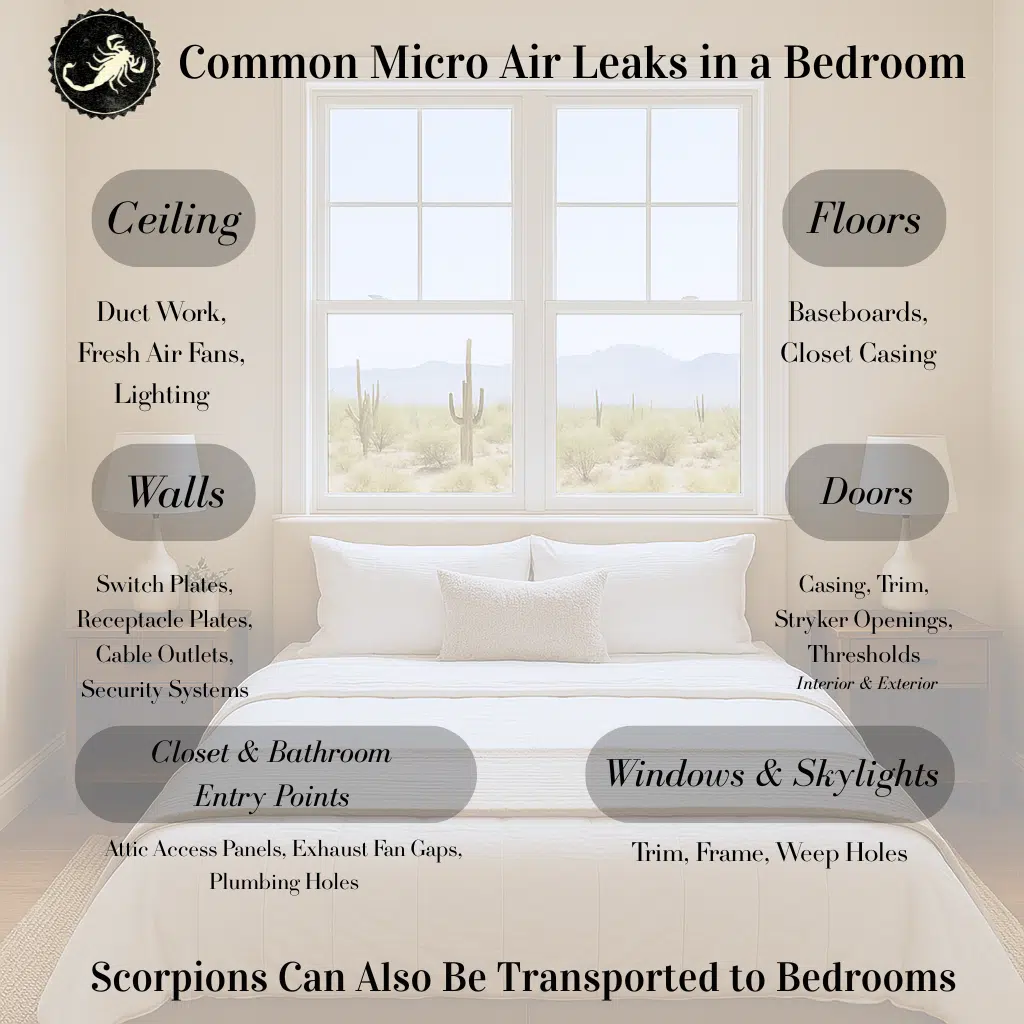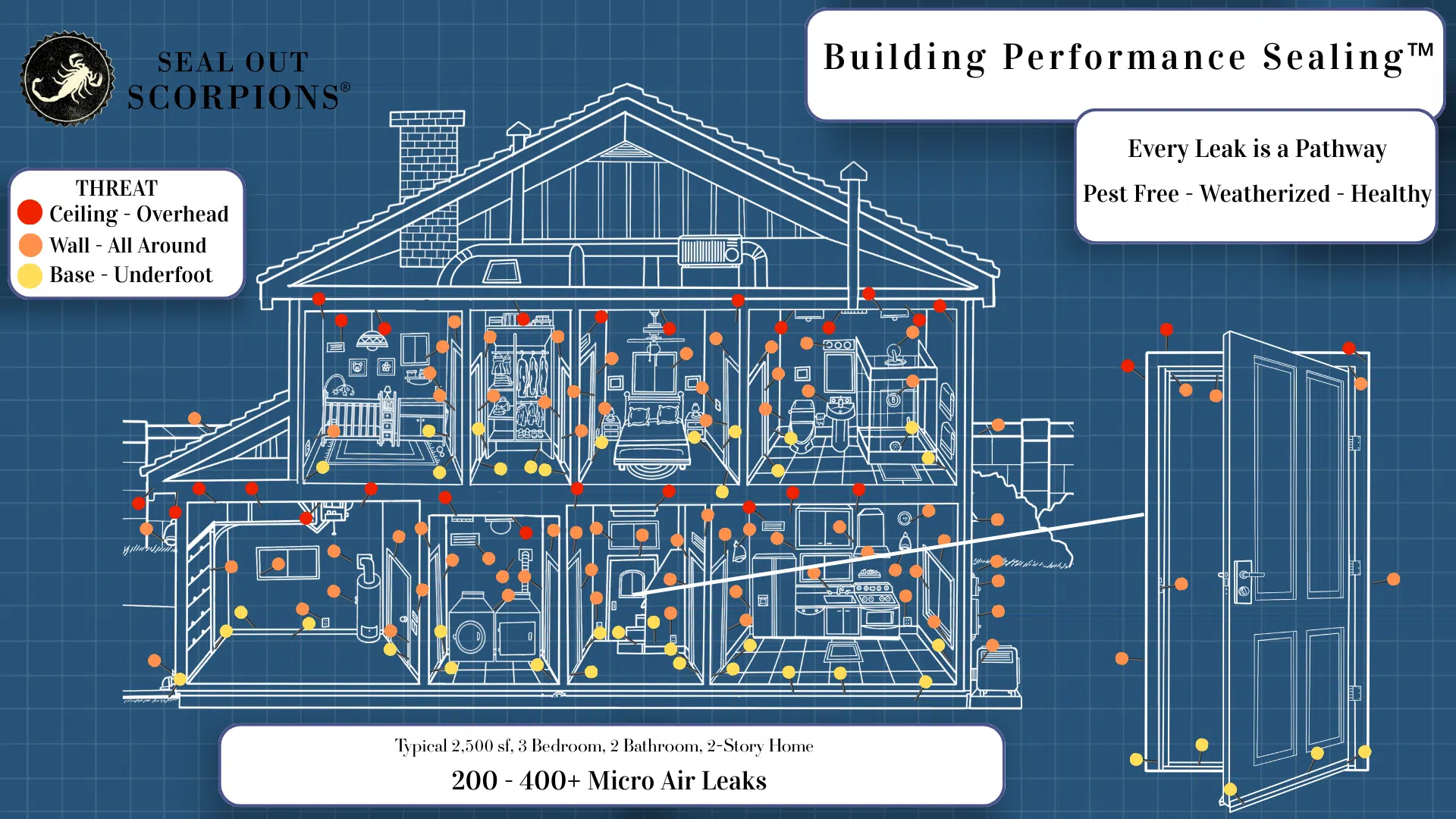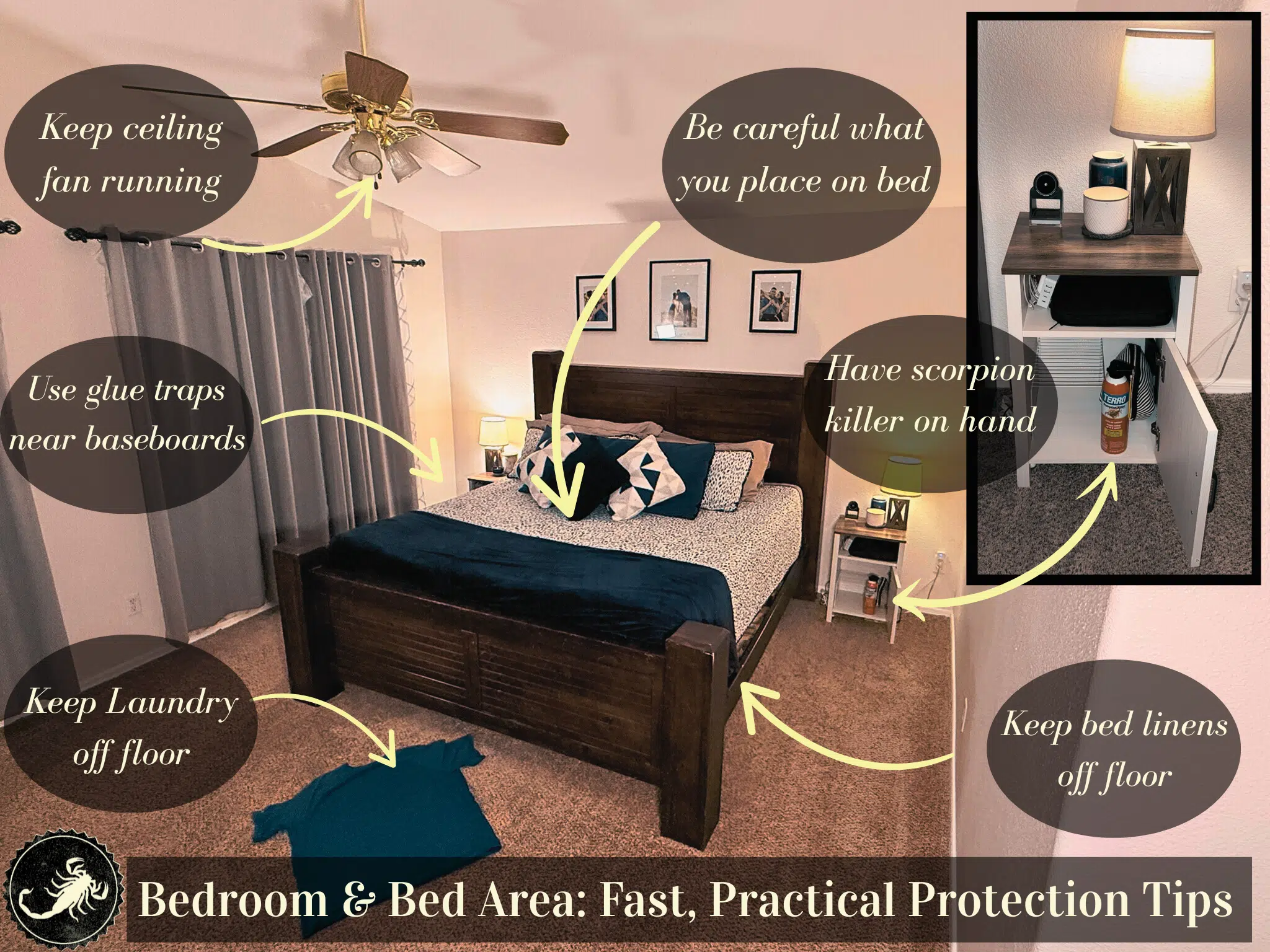Quick Take: Scorpions In The Bedroom
- 42.5% of stings happen in bedrooms
- 1 in 5 stings occur while people are asleep in bed
- Arizona leads the U.S. in scorpion stings (68% of all reports)
- Children & pets at highest risk
- Antivenom treatment can exceed $50,000
- Most stinging scorpions are distressed or chemically disoriented
- Prevention starts with sealing, not spraying
Are You More Likely To Be Stung By a Scorpion In Your Bed Than In Your Backyard?
The answer is yes, and the numbers are hard to ignore.
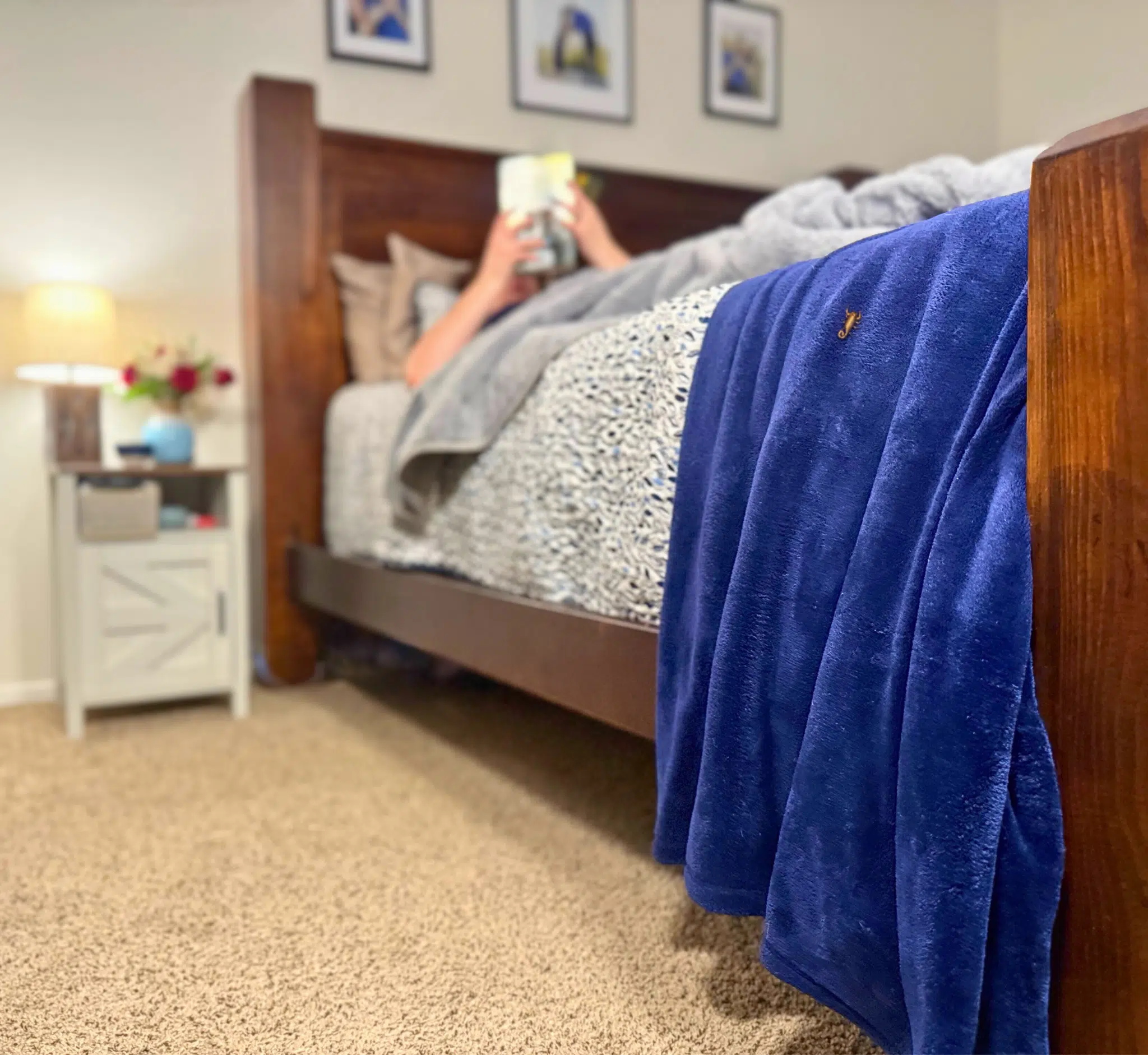
42% Of Scorpion Stings Occur In Bedrooms: What The Data Shows
According to a 2020 study from the University of Arizona College of Medicine (Bennett et al., 2020), 42.5% of scorpion stings happen in bedrooms, and more than half of those occur while the person is in bed. That is not just a statistic. That was my story, too.
I was stung while sleeping. But what makes it unforgettable is that the scorpion had been on my nightshirt for about ten minutes before I realized it. I moved out of the house that night at 1 a.m. and never spent another night there again. That decision may sound extreme, but I am not alone. Over the years, countless clients have shared similar experiences. Some were stung in their sleep. Others while folding laundry. Picking up a damp towel. Putting on shoes. Reaching under a pet water bowl. Even from toys their kids left out.
Scorpion stings happen in all kinds of scenarios, but the data backs up what our clients know all too well: they often occur in places that feel safe.
At Seal Out Scorpions, we have studied the science, the research, and the scorpion sting data, including envenomation reports from the National Poison Data System, every year since we were founded in 1999. We do not guess. We study patterns, outcomes, and structural vulnerabilities so that what we do is not just reactionary. It is preventative, proven, and aligned with the biology of the threat.
The LOGIC
Arizona: The Bark Scorpion Capital Of the U.S.
Arizona is home to the Centruroides sculpturatus, the Arizona bark scorpion, the only scorpion species in North America capable of causing systemic, sometimes severe, envenomation (Becker et al., 2013). While bark scorpions are also found in parts of New Mexico, Nevada, California, Utah, Texas, and northern Mexico, Arizona leads the nation in sting reports, accounting for nearly 68% of all scorpion-related poison center calls in the U.S. from 2005 to 2015 (Forrester et al., 2017).
Scorpion sting statistics in the U.S. are tracked by the National Poison Data System (NPDS), the real-time surveillance database maintained by America’s Poison Centers. Each year, NPDS publishes an annual report summarizing over 2 million poison exposure calls from all 55 U.S. poison centers. These reports, published in the peer-reviewed journal Clinical Toxicology, are the gold standard for national exposure tracking and form the basis of public health response, including envenomation data, severity outcomes, and treatment interventions (Gummin et al., 2021).
This is not due to coincidence. Our climate, construction practices, and urban encroachment into desert habitats have created a perfect storm for human-scorpion interaction. Modern developments create dense, irrigated landscapes with artificial moisture sources, ideal for prey insects and therefore for scorpions.
Understanding The Indoor Threat: Bedrooms, Living Spaces & More
The same University of Arizona research found that 86.5% of scorpion stings happen indoors. Bedrooms accounted for 42.5% of these, followed by living rooms (24%) and bathrooms (6%) (Bennett et al., 2020). The remaining incidents were spread across closets, laundry areas, garages, kitchens, and children’s play areas.
Of the stings that occurred in bedrooms, 54.7% happened in bed, and 72.7% of those occurred while the individual was asleep. That means roughly 1 in 5 scorpion stings in Arizona happens while someone is sleeping in bed. This is more than a public health statistic. It is a pattern. It is a wake-up call to recognize that the spaces we consider safest may be more exposed than we think.
Scorpions favor bedrooms because they offer still, protected environments with soft hiding spaces. Beds that touch walls, overhanging linens, and baseboards with micro gaps all create easy access points. Add in nightstands, stacked laundry, or clutter near the floor, and you have the perfect setup for a sting in the night.
The Mechanics Of Entry: How Scorpions Get Inside
Bark scorpions are uniquely suited to infiltration. They are flat-bodied, light-colored, and able to squeeze through gaps as small as 1/16 of an inch. They climb stucco, crawl behind electrical faceplates, and maneuver through unsealed weep screeds and around attic ductwork.
Common Entry Points Include Hundreds Of Micro Air Leaks Throughout The House:
- Duct and utility penetrations
- Electrical wall components
- Plumbing components
- Cabinetry trim and baseboards
- Weak door thresholds and weather stripping
- Exterior harborage areas
Unlike many other pests, bark scorpions do not respond to deterrent sprays by avoiding entry. They simply redirect.
When Scorpions Sting In The Home: They Are Distressed, Not Healthy
There is a public misperception that scorpions that sting are healthy, thriving predators. Field experience tells a different story. The scorpions most likely to sting are often distressed. They have been displaced by environmental pressure, disoriented by chemical applications, or dehydrated in the hunt for moisture.
General pest control applications often exacerbate the risk. Most over the counter and even many commercial pesticides do not kill bark scorpions quickly unless they are directly in contact. Residual products can take weeks or months to kill an individual scorpion. They may dislodge scorpions from their harborage, driving them further into the home and into less desirable areas. These distressed scorpions move more slowly, appear more often in odd places, and are more likely to sting defensively instead of retreating and protecting themselves.
Several pest control professionals and toxicologists have noted that scorpions exposed to residual pyrethroids demonstrate increased erratic movement (Shelton et al., 2016). While not all exposures are lethal to the scorpion, sublethal exposure alters behavior and increases the chances of human contact unless strategies are very prescriptive.
Children & Pets: Elevated Risk Groups
Children under six are at the highest risk of severe systemic symptoms from bark scorpion stings. According to the National Poison Data System’s 2021 report (Gummin et al., 2021), children account for a substantial portion of the 28 major medical outcomes and nearly all cases requiring antivenom intervention for scorpion envenomation. Pediatric hospitals in Arizona, including Banner Children’s, have documented dozens of hospitalizations each year, with infants and toddlers most frequently affected. Children can be stung while retrieving a toy, article of clothing, in a bath and shower or in a crib or bed where a scorpion was hiding. Because they are smaller in mass, the same volume of venom has a greater systemic effect.
Pets too, especially cats and small dogs, are at risk. We have received countless calls from homeowners reporting yelps, limping, or swelling after a sting. In some cases, the pet discovered the scorpion before the homeowner even knew it was present.
Antivenom & Hospitalization Costs
Most people assume antivenom is readily available and inexpensive. It is not. Anascorp, the only FDA-approved antivenom for Centruroides sculpturatus, is outlined in detail by the FDA and CDC as the only effective treatment for severe scorpion envenomation in the U.S. (FDA.gov, CDC). Cost analysis from Arizona hospital billing data shows charges ranging from $3,780 to over $12,467 per vial, depending on the facility and negotiated rates. Most treatments require three to five vials. What cost about $100 per vial prior to the early 2000’s, today’s cost can easily exceed $30,000 to $50,000.
Not all hospitals stock Anascorp on site, and some patients must be transferred, delaying care. It’s wise to have a plan in place for a scorpion sting and which hospital you would go to, especially with a young child or someone at higher risk. By comparison, preventing scorpion stings through Building Performance Sealing, targeted pest control, and proactive environmental management is far more cost-effective and significantly healthier and safer for your family.
Beyond Bedrooms: The Lesser-Known Sting Zones
Even though bedrooms lead the data, sting reports cover a wide range of locations:
- Sitting on furniture: couches, recliners, floor cushions, and even the toilet
- Folding or picking up damp towels
- Inside laundry baskets or washing machines
- Toys left outside or on the floor
- Beneath pet water dishes or pet beds
- Inside shoes or boots
- Inside gloves, hats, or bags
- Stepping barefoot onto carpet, tile, wood, or garage floors
- Reaching for utensils in a drawer or from one in a coffee cup
- Many other odd and uncharacteristic places
One unforgettable case was when a client was stung on his private part by a scorpion that dropped from an exhaust fan while sitting on the toilet. The story may sound extreme, but it is real. Scorpions often hide in ceiling fixtures or around duct boots and are known to fall out onto surfaces below. This illustrates how unpredictable and deeply personal scorpion encounters can become.
The unifying theme is stillness, darkness and distressed behavior. Scorpions prefer to remain concealed and still until disturbed unless erratic from powders or sprays. And when they feel threatened, especially after being chemically disoriented, they sting.
What Homeowners Usually Get Wrong
- Believing they’re safe if scorpions are “only outside.” Many think that as long as sightings are limited to the yard, garage, or exterior walls, there’s no real threat indoors. In reality, these are early warning signs that the population is active and exploring; that progression indoors is likely over time.
- Thinking bedrooms are safe if scorpions are only in kitchens or downstairs. This is a common and dangerous misconception. In many cases, sightings in these “lower risk” areas are simply the early stages. Without proper sealing, scorpions can and often will find their way into upstairs bedrooms, especially when driven by weather shifts or pest control treatments.
- Relying solely on general pest control sprays without truly understanding what they can and can’t do. Many homeowners don’t realize that most general pest insecticides have little to no quick-kill effect on bark scorpions unless applied directly. The chemistry often works slowly, or not at all, on scorpions. Many general pest control technicians do not even fully understand how to minimize flushing and maximize results based on chemistry and scorpion science. This lack of awareness can lead to a false sense of security while scorpions continue to roam in wall voids or indoors.
- Partial sealing or “spot” fixes. Sealing only certain areas can create air pressure changes that draw scorpions inward through unsealed gaps that are not obvious, redistributing rather than solving the problem.
- Believing that “no sightings” means “no scorpions”. Bark scorpions are nocturnal, reclusive, and can live in concealed areas for long periods without being seen. Lack of regular sightings is not proof of absence.
- Trusting deterrent myths. Coffee grounds, citrus peels, lavender, ultrasonic devices, and most “DIY hacks” have no lasting effect on bark scorpions in the Southwest.
Have Questions About Scorpion Safety?
We’re always happy to share what we’ve learned from decades of studying scorpion behavior and sting patterns. Whether you work with us, another provider, or take a do-it-yourself approach, we can help you understand the risks and the most effective prevention strategies.
The SOLUTION
Strategies That Work: Why Sealing Is Essential
Seal Out Scorpions was founded on the belief that traditional pest control methods fall short when it comes to bark scorpions. The key is not just killing what you see. It is preventing their entry entirely.
Building Performance Sealing is a method we pioneered that goes beyond caulking. It addresses micro air leak points from foundation to attic, identifies structural vulnerabilities, and applies proven sealing solutions designed to block even the most agile pests. This includes:
-
Foundation perimeter sealing
Attic duct and fixture protection
Crawlspace and garage threshold solutions
Weep screed sealing with ventilation balance
Baseboard and utility gap corrections
And much more
When combined with prescriptive pest control that considers scorpion behavior, moisture gradients, and prey suppression, it creates an environment where scorpions cannot thrive or even enter.
Closing The Gap Between Comfort & Safety
Too often, homeowners rely on a sense of normalcy until they or someone they love is stung. Our goal is to remove that risk before it becomes real. When a client calls us after a sting, our team shows up with empathy and evidence. We explain the biology, the behavior, and the path forward.
You should not need a black light to feel safe in your own home. You should not avoid the floor. And you should not have to worry about what might be inside you or your toddler’s shoe.
We work to end that uncertainty. We achieve this with the tools, experience, and data to back it up.
If you are seeing scorpions, or if you are not but want to make sure it stays that way, we are here to help, even in just education and to help you avoid mis falls. Safety in your home should not be a gamble. And peace of mind should not depend on luck.
Scorpion-Proofing Checklist: Bedroom & Beyond
Long-term solutions for Arizona homes and Quick Steps to Better Protect Bed
Curative & Preventative Action: Whole-Property Solutions
For full scorpion cure and prevention, the entire property and neighboring threat must be addressed:
- Neighborhood Assessment: Understand surrounding scorpion pressure, irrigation and water sources, and surrounding terrain.
- Building Performance Sealing: When done holistically with a highly skilled team looking at the big picture, this method blocks micro air leaks throughout the structure while keeping high integrity of the home.
- Property Microclimate & Profile Assessment: Identification of micro-climates, moisture gradients, concealment zones, and prey density (not so much for food source, but favorable conditions for insects will be highly favorable conditions for scorpions).
- Prescriptive & Advanced Scorpion and General Pest Control: Focused on preventing scorpions from being flushed into the home, blocking entry points like doors, and repelling them to reduce both on-site activity and neighborhood population flow.
If Building Performance Sealing and advanced pest control are not in the budget, not your preferred approach, or you need faster protection, the Bedroom and Bed Area Checklist provides effective steps you can take immediately on their own.
Important Note On Sealing:
We never recommend partial sealing: except when limited to ceiling or over-bed zones. Incomplete sealing can create pressure differentials that draw scorpions inward through unsealed gaps.
Effective prevention requires understanding scorpion pathways, thermodynamics, and air pressure movement. For best results, don’t start where you think the problem is: start by protecting the places you never want to find one. Scorpion control isn’t about exterminating; it’s about redirecting their path: and not into a different undesirable area.
Bedroom & Bed Area: Fast, Practical Protection Tips
- Keep ceiling fans running 24/7, even on low. Wind currents and vibration can deter scorpions from ceiling surfaces.
- Ensure bed linens do not touch the floor. And avoid placing beds/cribs against walls.
- Keep laundry, towels, and personal items off the floor near the bed, especially if damp.
- Place non-poisonous glue traps behind beds, under nightstands, behind dressers, and along undisturbed baseboards to catch movement overnight.
- Have a can of Terro Scorpion Killer on hand for emergency contact kills (never use for prevention and residual spraying).
- Do not spray insecticides in the bedroom unless it’s a contact killer – see it, spray it, kill it. Residual or repellent sprays can flush scorpions into walkways, furniture, clothing or beds.
- Avoid placing items such as purses, packages, laundry baskets, etc., on the bed. These can transport a scorpion to the bed.
- Vacuum bedroom floors regularly, especially under furniture and along walls.
- Do not place throw-pillows or decorative bedding on the floor, then return them to the bed.
- Inspect laundered linens before placing them on the bed. Scorpions can hide in dried sheets or blankets.
- Avoid storing baskets, bins, or fabric boxes under beds or nightstands. These are ideal harborage areas.
- Avoid relying solely on blacklights. They are useful for inspection but should not be considered a prevention tool. It’s just an inspection in a moment of time, and often like looking for a needle in a haystack.
- CAUTION on partial sealing unless it is limited to ceiling or over-bed areas. Partial sealing may worsen conditions by increasing pull-through pressure from unsealed gaps and re-route scorpions to less desirable areas.
Need Help Locating a Scorpion You Know Is Hiding In Your Bedroom?
Need Immediate Or Expert Scorpion Help?
If you have a scorpion hiding in your bedroom, have recently seen one in your home, been stung, or gone through repeated services that haven’t solved the problem, we can help. Call or text 480-820-7325 or email support@sealoutscorpions.com and we’ll walk you through what’s really happening, how to find and remove a hidden scorpion, and what steps will actually protect your home for the long term.
About Seal Out Scorpions®
Seal Out Scorpions is led by Georgia A. Clubb, Advanced Scorpion Specialist, together with William L. Clubb and Michael C. Golleher — Certified Building Analysts and Envelope Professionals through the Building Performance Institute, with additional Building Science Certificates and studies in Urban & Industrial IPM through Purdue University. Their team includes licensed pest management and sealing specialists who pioneered Building Performance Sealing to solve scorpion problems at the structural level.







